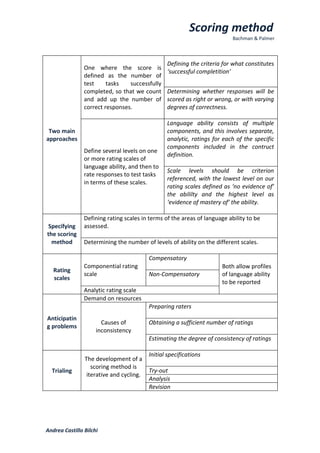
Summary (chart)
- 1. Scoring method Bachman & Palmer Defining the criteria for what constitutes One where the score is ‘successful completition’ defined as the number of test tasks successfully completed, so that we count Determining whether responses will be and add up the number of scored as right or wrong, or with varying correct responses. degrees of correctness. Language ability consists of multiple Two main components, and this involves separate, approaches analytic, ratings for each of the specific components included in the contruct Define several levels on one definition. or more rating scales of language ability, and then to Scale levels should be criterion rate responses to test tasks referenced, with the lowest level on our in terms of these scales. rating scales defined as ‘no evidence of’ the abililty and the highest level as ‘evidence of mastery of’ the ability. Defining rating scales in terms of the areas of language ability to be Specifying assessed. the scoring method Determining the number of levels of ability on the different scales. Compensatory Componential rating Both allow profiles Rating scale Non-Compensatory of language ability scales to be reported Analytic rating scale Demand on resources Preparing raters Anticipatin Causes of Obtaining a sufficient number of ratings g problems inconsistency Estimating the degree of consistency of ratings Initial specifications The development of a scoring method is Trialing Try-out iterative and cycling. Analysis Revision Andrea Castillo Bilchi
